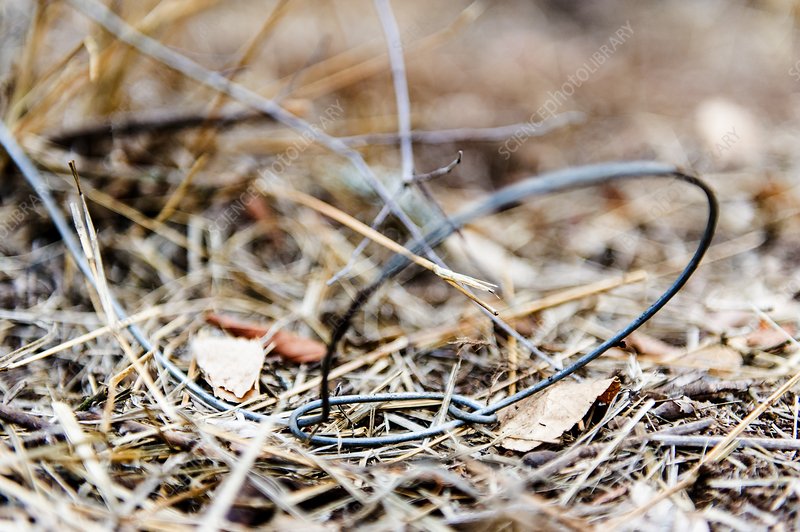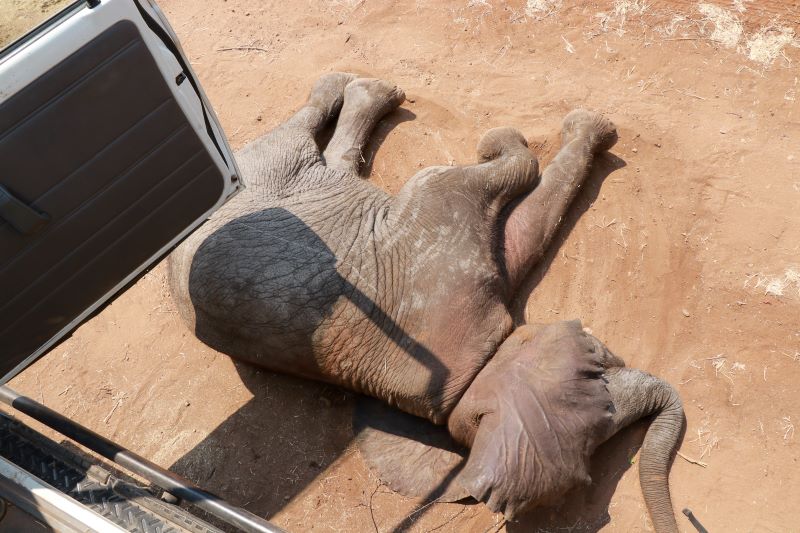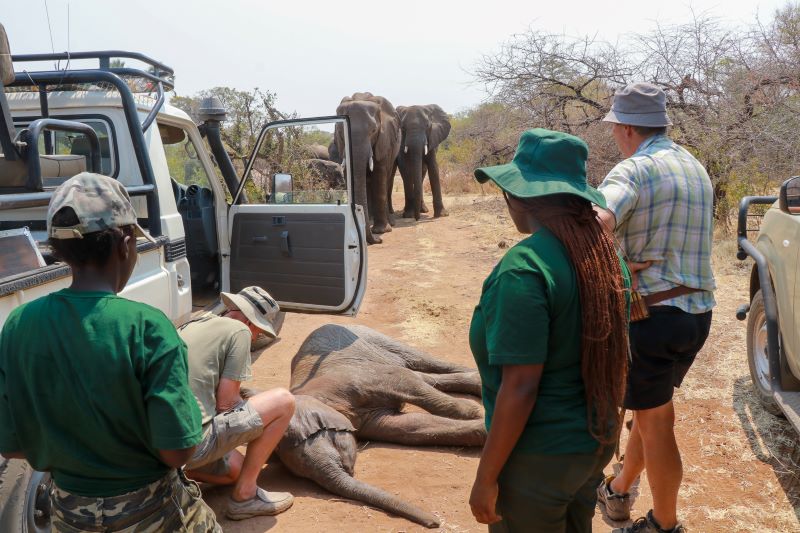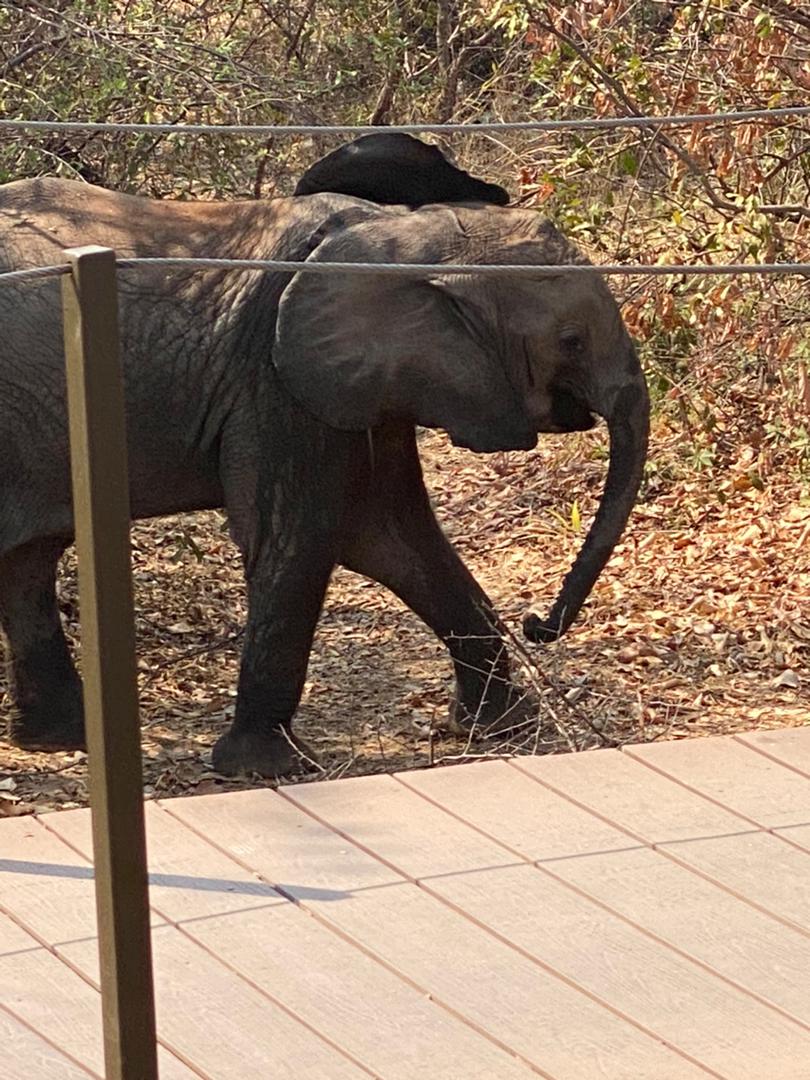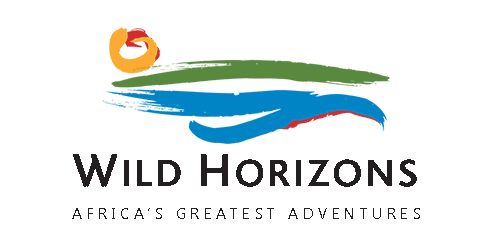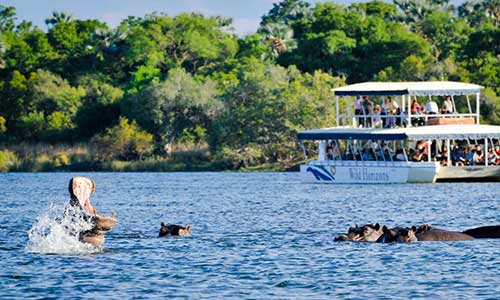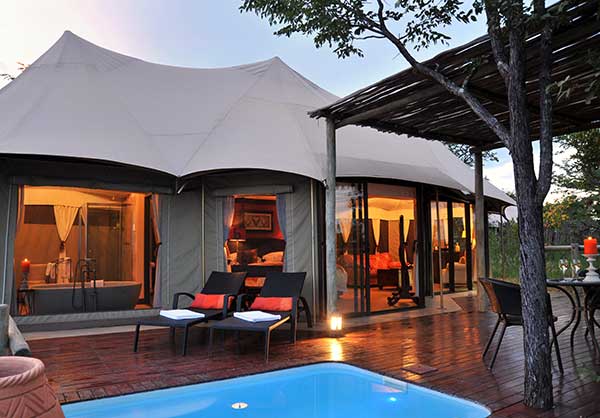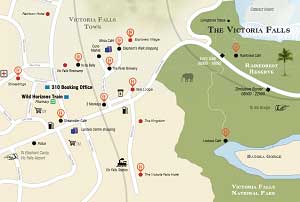Oct 1, 2023 | Eco Tourism, Green Tourism, Old Drift Lodge, safari guide, Safaris, Sustainiable Tourism, Victoria Falls, Victoria Falls Wildlife Trust, Wildlife
Collaborative Conservation Efforts in the Zambezi National Park
In the expansive wilderness of the Zambezi National Park, Old Drift Pro Guide, Vusa Sibanda, discovered a distressing scene that would set in motion a remarkable and heart-warming tale of heroic conservation efforts. Within a tight-knit herd of approximately 15 elephants, a young calf was found in a desperate plight, ensnared by a wire snare that had inflicted deep and painful wounds around its neck.
While poachers mostly target antelope and other smaller game, the snares are indiscriminate. The crude, noose-like traps often maim or kill non-targeted animals such as lions, giraffes and in this case, a baby elephant.
Vusa called Leslie, the Old Drift Lodge manager on duty at the time, and Les wasted no time in reaching out to the Victoria Falls Wildlife Trust, urgently seeking their assistance. The Trust’s dedicated team has successfully freed hundreds of snared animals, including giraffes, buffaloes, lions, hyenas, elephants, kudus, waterbucks, warthogs, and impalas. They arrived at the scene, ready to embark on a challenging rescue mission.
The very nature of snares makes them nearly impossible to remove; the harder an animal pulls, the tighter the snare gets, and rescuing a trapped baby elephant within a protective elephant herd is a complex and risky endeavour.
To minimize potential danger from the anxious mother during the rescue, the mother and calf were simultaneously darted with a sedative.
The injured calf sought solace closer to its mother, and one of the quick-thinking guides manoeuvred a vehicle to gently guide the mother away, ensuring the safety of the rescue team and the vulnerable calf.
Once the calf was safely immobilized, the team carefully approached, skilfully removing the wire snare that had inflicted so much pain. With utmost care and precision, they treated the wounds before reversing the sedative’s effects. As the baby elephant regained consciousness, it instinctively tried to reunite with its mother, but a protective sibling intervened, shielding her tranquillized mother from any harm.
As the sedatives wore off and both elephants awakened, the emotional climax of this remarkable rescue unfolded as the mother and calf were reunited. With their wounds tended to and their spirits rekindled, they rejoined the rest of the herd, who had remained close by, protectively observing the entire operation.
This incredible rescue mission would not have been possible without the heroic efforts of individuals like Adrian Read, Vusa Sibanda, the support of Zimparks, the dedication of Les and Old Drift Lodge, and the unwavering commitment of The Victoria Falls Wildlife Trust.

Small Actions Create Huge Change: How You Can Support the Victoria Falls Wildlife Trust
Since its inception, the Trust has tirelessly worked to remove snares from National Parks areas in the Victoria Falls region and rescue wildlife trapped by the contraptions. Each rescue mission requires drugs, medications, sterile equipment, sampling supplies, as well as personnel and vehicle/aerial support. The drugs and equipment used to remove the snare from 1 elephant cost approximately USD $250.00. If you would like to support their rescue missions, you can make a donation on their website. Find out more here: https://vicfallswildlifetrust.org/projects/fighting-wildlife-crime/
Nov 3, 2020 | Author : Jess White, Eco Tourism, Family Friendly Activity, High Water, rafting, safari guide, Safaris, Things to do in Victoria Falls, Victoria Falls, Victoria Falls, Victoria Falls, Victoria Falls Activities, white water rafting, Zambezi river, Zimbabwe
The Positive Impact of Negative Ions: Your Wellness Safari In Victoria Falls
When you step into a raw, natural space, something shifts – emotionally, physically and mentally. Nature inspires a sense of empowerment and tranquillity, igniting an electrifying paradox of sensations. Anyone who has done a tour of the Victoria Falls rainforest will understand the intoxicating feeling, but not everyone understands what causes this euphoric state. Beyond the beauty of this Natural Wonder, there is something else at work here – negative ions.

What is the Difference Between Positive and Negative Ions?
Quite simply, positive ions have lost one or more electrons, whereas negative ions have gained electrons. Though we might assume that ‘positive’ is synonymous with ‘better’, the true meaning of these terms have collapsed into their connotations and can cause confusion. Negative ions produce biochemical reactions that increase serotonin levels. This helps to:
- Alleviate depression
- Relieve stress
- Boost our daytime energy
Positive ions, on the other hand, have lost their electrical charge and the benefits that go with it.
Negative ions are created as air molecules break apart due to sunlight, radiation, and moving air and water. This is why we feel uplifted by thunderstorms and inspired by waterfalls.
Negative Ions Make You More Alert And Energetic
The environment in urban areas disrupts the delicate balance of ions. Artificial lighting and air conditioners deplete negative ions, causing people to feel lethargic and demotivated. Throughout lockdown, people have navigated the world from behind screens that bombard us with positive ions. A safari in Victoria Falls will influence your health measurably and positively. It is more than the roar of rushing water or the beauty of a rainbow on rainless afternoons – a safari in Victoria Falls is health generating as well as breathtaking. Now more than ever, we need to escape toxic environments for the healing power of nature.
Waterfalls and rapids are the hydraulic equivalents of fireworks. Whether you are rafting down white water rapids, or even swimming above the Victoria Falls in Devil’s Pool, negative ions will generate an increased flow of oxygen to the brain to make you more alert and energetic.
Would you like to receive regular updates from Victoria Falls? Our writing team are your insiders to this incredible destination and you can have our Monthly Newsletters sent directly to your inbox. Subscribe to our mailing list for inspiring stories and all the Vic Falls Need-To-knows! It’s free and you can unsubscribe at any time.
May 15, 2019 | Green Tourism, Guides, meetourpeople, safari guide, Sustainiable Tourism, Victoria Falls, wildhorizons
Vusa Sibanda’s journey to becoming a guide began in the Matetsi region of Zimbabwe, where he worked as a tracker for eight years. Roaming along animal superhighways, Vusa would use misplaced twigs, imprints in the sand and naked tree branches to draw a map in his mind, illustrating wildlife movements that would be indecipherable to the untrained eye. Recognizing his talent, recruiters for the FGASA program offered Vusa the opportunity to spend two months in South Africa to complete his guide-training course. Five years later, Vusa is a highly respected and valued guide at Old Drift Lodge. While his days as a tracker have drawn to a close, Vusa’s boundless knowledge of the bush and his acute attention to detail is reflected in his exquisite wildlife photography. 
Vusa’s Instagram page resembles an archive of experiences and safari moments frozen in time through the lens of his Canon Camera. Scrolling through the images will take you on a sentimental journey back into some of the most wild and untouched places on earth. “One thing I have learned being in the bush, is that every animal, tree and stretch of landscape has its own character”, muses Vusa. “I am in the wilderness everyday and have been since I was young, but I am always excited to go on the river and on a game drive because I know that the wilderness will show me something I have never seen before”. While many people will scour the National Park looking for big game, Vusa believes that the subject of the photograph is not necessarily what determines a great shot. It is the moment that they spring into action, be this a bird in flight, a lion yawning, or a buck prancing through the trees. Outside his lens you might see a bird nesting or hippo wallowing, but the gentle click of his camera is reserved for the fleeting moment that they take off, or tear open the surface of the Zambezi River, leaving him with a hard copy of that powerful moment.
Vusa’s camera has been an ever-present companion on his ventures into the wilderness and his passion has become a vessel through which he shares his expertise with guests at Old Drift Lodge. In an increasingly digital world, memories of the present are scrolled instantly into the past. However, Vusa’s images will compel you to look closely, look twice and look slowly. Through the glass screen of your phone or desktop, you can peer into his wild world and understand what it looks like in a given moment.
@vusasibanda2002
Oct 30, 2017 | birding safari, Family Friendly Activity, Guides, safari guide, Things to do in Victoria Falls, wild horizons activities, wildlife encounter
A Day Trip to Chobe
Chobe National Park is renowned for its large herds of elephant that frequent the Chobe River on a daily basis. In the dry season an estimated 85,000 elephants make Chobe National Park their home, mainly in close proximity to the river. However, Chobe is also home to a plethora of other African wildlife. Game drives offer regular sightings of lion, leopard, buffalo and a whole host of antelope including sable, puku, kudu, eland and roan.
The river offers up its own incredible sightings of huge pods of hippo grazing on the swampy islands interspersed with some of the largest crocodiles in Africa basking  themselves on the extensive flood plain and open sand banks. Chobe National Park is also an ornithologist’s paradise – the banks of the river are lined with the nests and holes of some of the most colourful and spectacular birds in Africa and a myriad of birds of prey call Chobe their home.
themselves on the extensive flood plain and open sand banks. Chobe National Park is also an ornithologist’s paradise – the banks of the river are lined with the nests and holes of some of the most colourful and spectacular birds in Africa and a myriad of birds of prey call Chobe their home.
This tour departs daily to the Chobe National Park in Botswana. Clients will be transferred by bus to the Kazungula border post. They will be assisted through customs formalities by the Wild Horizons driver before being handed over to their Botswana guide. Once they have been assisted through the Botswana border formalities, Chobe Marina Lodge is the next stop for a quick bathroom break and signing of indemnity forms. Guests will proceed straight to the morning cruise where they will spend the morning game viewing along the Chobe River. All the boats offer protection from the sun. The cruise will end at around 12h30 and clients will go back to the lodge for an extensive buffet lunch. The lodge is situated on the river banks overlooking the Chobe River and the Namibian shoreline. After lunch, guests will board safari vehicles for an afternoon game drive into Chobe National Park. After the drive guests will be taken back to the Kazungula Border where they will be met by their Zimbabwean guide for their return transfer to Victoria Falls.
When considering attractions in Victoria Falls, keep in mind the magnificent Chobe National Park is very easily accessible and makes for a fabulous fun filled day!
Important details:
Times:
• 07:00 to 07:30 – Guests will be picked up from their hotel, in a closed bus, and proceed on a 70km journey on a tar road through Zambezi National park and designated safari areas to the Kazungula border.
• 08:30 – Arrival at the Kazungula Border, where guests will exit Zimbabwe/Zambia and enter Botswana. At the border guests will change vehicles and are met by their Botswana guide.
• 08:45 – Once guests have gone through Botswana immigration, they will take a short drive to Chobe Marina Lodge.
• 09:00 to 09:15 – Arrival at the lodge, where guests will have a short bathroom break, and will also be required to fill out the Park Entry form.
• 09:30 – Depart on guests’ first activity; EITHER game drive or boat cruise. If guests would like to go on a specific activity first, then they should please specify. Soft drinks, local beer and bottled water are provided on all safaris and river cruises.
• 12:30 – Return to the hotel for lunch. This will be served a buffet style lunch, with a selection of traditional and modern day meals to choose from.
• 13:30 – Depart for guests’ second activity. This will be either a game drive or a boat cruise, depending on what activity the guests did in the morning.
• 16:00 – Return from the Park and head back to the Kazungula Border to proceed with border formalities.
• 16:30 – Guests will meet their Wild Horizons bus and are transported back to their hotel.
• 17:30 – Arrive at guests’ hotel.
Duration: 11 hours
Departures: between 07h10 and 07h30
Minimum: 1
Maximum: 9 per vehicle
Age Restrictions: Children 2-11 years are half price, over 12 pay full price.
IMPORTANT NOTE:
Botswana requires an unabridged birth certificate for all minors travelling to Botswana (this has been in effect since October 2016).
The following documents are required when travelling to Botswana with minors (18 years and below):
- Valid Passport
- Valid VISA, if required
- Unabridged Birth Certificate (Birth Certificate containing the particulars of a minor and those of the parents)
- A letter of consent from the other parent should the minor be travelling with one parent
*Please note that a normal birth certificate will not be accepted.
Minimum age: We accept children younger than 2 years but on a private trip basis.
Maximum age: N.A
Language: English (French, German, Italian & Spanish available on private tours, at supplement cost – subject to availability)
Transfers: Included from hotels in Victoria Falls Town
Please note: the order of the activities are subject to change without prior notice.

Apr 14, 2016 | Family Friendly, Family Friendly Activity, Guides, safari guide, Safaris, Things to do in Victoria Falls, Victoria Falls, Wild Horizons Activites, wild horizons activities, Wildlife
The muggy afternoon heat was beginning to dissipate as Mike, our incredibly knowledgeable and charming guide, arrived to collect us from The Stanley and Livingstone. Almost immediately we saw a herd of zebra. This fairly common sighting suddenly became an interesting study in how zebra stripes act as a private air conditioning system, allowing them to stay blissfully cool in the heat of a Zimbabwean afternoon. Equally fascinating, although less romantic, we learnt that within the first few days of being born, baby zebras eat their mother’s dung. This provides them with roughage and ample bacteria to fight off infection during their vulnerable first days.
 Suddenly we were startled by a warthog whose impressive size and demeanor was somewhat diminished by the very obvious lack of his tail. Mike explained to us that it is common to see warthogs with no tails on the 6000-acre reserve, as there is fierce competition between warthogs and hyenas for the limited number of burrows. About 70% of the warthogs have lost their tails from reversing into a burrow and finding it occupied by sharp fanged rivals!
Suddenly we were startled by a warthog whose impressive size and demeanor was somewhat diminished by the very obvious lack of his tail. Mike explained to us that it is common to see warthogs with no tails on the 6000-acre reserve, as there is fierce competition between warthogs and hyenas for the limited number of burrows. About 70% of the warthogs have lost their tails from reversing into a burrow and finding it occupied by sharp fanged rivals!
Alerted by the smell, we were thrilled to see a pile of rhino faeces on the road. Mike explained to us how rhino have a unique system of detecting the presence of other rhino in the area. Male rhino ensure that after defecating they leave traces of urine and faeces on their back legs. These ‘calling cards’ drop off as he walks, clearly demarcating his area for other would-be trespassers! Female rhino dung can indicate an increase in oestrogen for potential suitors in the area.
Much like we humans will sniff a glass of wine trying to discern different scents and notes, so a rhino employs a similar, albeit rudimentary method to glean information. So the next time you raise a glass of wine to your nose and inhale deeply, think of the rhinos, one of which could be doing exactly the same thing at the same time. Cheers to you both!
Our glorious afternoon was complete when suddenly we came across not one, but five Black Rhino! Unperturbed by our presence and obvious excitement, these magnificent creatures strolled leisurely up to our vehicle, sniffing (of course) the air inquisitively and coolly regarding their star struck visitors. We realized how supremely privileged we were to see these 5 rhino (the herd comprises 7 in total) when Mike pointed out that the total black rhino population in the world stands now at a mere 1500. Depressing news indeed! For this reason the rhino on the reserve are regularly de-horned to deter poachers.
After the privilege of watching these incredible creatures, we made our way to the dam. Progress was delayed firstly by a herd of elephants waiting patiently for the babies to stop gambolling on the road and then by an enormous herd of buffalo whose progress indicated that they too were feeling the lethargy and peacefulness of the early evening. After a glorious sunset, accompanied by perfectly made gin and tonics, delicious nibbles and a myriad of bird activity, we reluctantly left this stunning display of nature to make our way home, all of us enriched by an incredible afternoon in the capable hands of Mike.

TIPS:
- Wear neutral coloured clothing, a hat and sunglasses.
- Take cameras and binoculars- there’s plenty to see!
